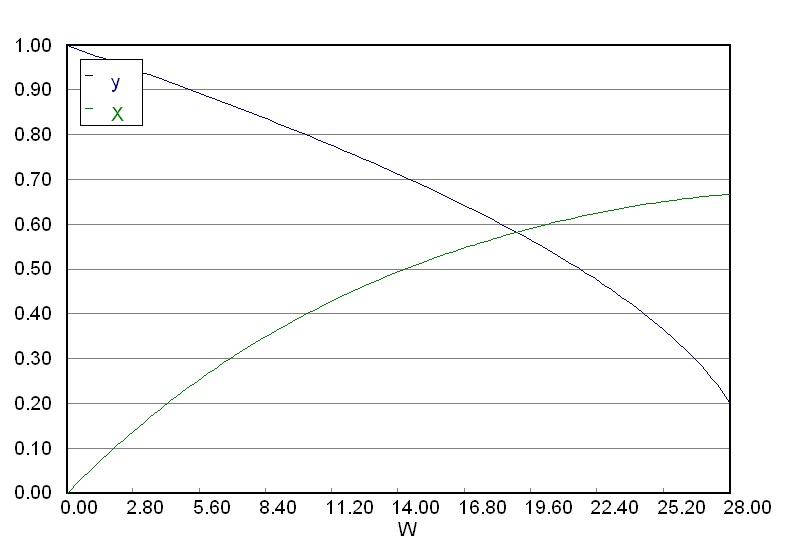Difference between revisions of "Software for integrating ODEs"
Kevin Dunn (talk | contribs) m (→Source code) |
Kevin Dunn (talk | contribs) |
||
| Line 73: | Line 73: | ||
from matplotlib.pylab import (plot, grid, xlabel, ylabel) | from matplotlib.pylab import (plot, grid, xlabel, ylabel) | ||
</syntaxhighlight> | </syntaxhighlight> | ||
If you experience problems importing these libraries, then re-install your Python distribution using one of the two options listed above. | |||
=== Source code === | === Source code === | ||
Revision as of 02:09, 25 February 2013
Example
Consider the pair of differential equations (covered in a class on 11 February): <rst> <rst-options: 'toc' = False/> <rst-options: 'reset-figures' = False/> .. math::
\dfrac{dX}{dW} &= \dfrac{-r_A'}{F_{A0}} \ \dfrac{dy}{dW} &= -\dfrac{\alpha}{2y}\left(1 + \varepsilon X\right)
Some terminology (recap from your pre-requisite math courses)
* The independent variable is
Since there are two dependent variables, we require initial conditions for each variable. In this case:
* :math:`X(0) = 0.0` * :math:`y(0) = 1.0`
We also need to specify initial **and final conditions** for the independent variable:
* :math:`W` initially is 0.0 at the reactor entrance * :math:`W` finally is 28.0 kg at the reactor exit
But there are a few other unknowns we must first specify:
* :math:`r_A' = -k' \dfrac{(1-X)y}{(1+\varepsilon*X)}` * :math:`q = \dfrac{(1 + \varepsilon X)}{y}` * :math:`F_{A0} = 0.1362\,\text{mol.s}^{-1}` * :math:`k' = 0.0074\,\text{mol.s}^{-1}\text{.(kg catalyst)}^{-1}` * :math:`\alpha = 0.0367\,\text{kg}^{-1}` * :math:`\varepsilon = -0.15` </rst>
Polymath
Download and install Polymath from the CD/DVD included with your course textbook (Windows only; sorry Mac and Linux versions are not available). Unfortunately this is only a 15 day version, which is pretty useless for this course, since you will require the code for at least the next 30 to 45 days. So rather use one of the other options below, if possible.
Enter the following Polymath code (as demonstrated in class on 11 February. Check the video out for a detailed explanation of the code.
# Differential equations
d(X) / d(W) = -rAdash / FA0
X(0) = 0
d(y) / d(W) = -alpha/(2*y) * (1+eps*X)
y(0) = 1.0
# Constants
FA0 = 0.1362 # [mol/s]
kdash = 0.0074 # [mol/(kg catalyst . s)]
alpha = 0.0367 # [1/kg]
eps = -0.15 # [-]
# Algebraic equations
rAdash = -kdash * (1-X)/(1+eps*X) * y
flow_ratio = (1 + eps*X)/y
# Initial and final values for independent variable:
W(0) = 0
W(f) = 28
Ensure that you obtain a graphical output as shown here. This represents the profile of conversion, 
Python
Installing Python
Installation differs from Windows to Linux to Mac. One Python distribution that works well for many people is the Enthought Python Distribution (EPD). Another one, especially for Windows users is Python(x,y).
Libraries required
You are ready to go if you enter the following without getting error messages:
import numpy as np
from scipy import integrate
from matplotlib.pylab import (plot, grid, xlabel, ylabel)
If you experience problems importing these libraries, then re-install your Python distribution using one of the two options listed above.
Source code
import numpy as np
from scipy import integrate
from matplotlib.pylab import *
def PBR_model(indep, depnt):
"""
Dynamic balance for the packed bed reactor (PBR); demo problem class 05C
indep: the independent ODE variable, such as time or length
depnt: a vector of dependent variables
X = depnt[0] = the conversion
y = depnt[1] = the pressure ratio = P/P_0 = y
Returns d(depnt)/d(indep) = a vector of ODEs
"""
# Assign some variables for convenience of notation
X = depnt[0]
y = depnt[1]
# Constants
FA0 = 0.1362 # [mol/s]
kdash = 0.0074 # [mol/(kg catalyst . s)]
alpha = 0.0367 # [1/kg]
eps = -0.15 # [-]
#Algebraic equations
rAdash = -kdash * (1-X)/(1+eps*X) * y
flow_ratio = (1 + eps*X)/y
# Output from this ODE function must be a COLUMN vector, with n rows
n = len(depnt)
d_depnt__d_indep = np.zeros((n,1))
d_depnt__d_indep[0] = -rAdash / FA0
d_depnt__d_indep[1] = -alpha/(2*y) * (1+eps*X)
return d_depnt__d_indep
# The "driver" that will integrate the ODE(s):
# -----------
# Start by specifying the integrator:
# use ``vode`` with "backward differentiation formula"
r = integrate.ode(PBR_model).set_integrator('vode', method='bdf')
# Set the time range
indep_start = 0.0 # kg
indep_final = 28.0 # kg
delta = 1.0 # the results will be shown only at these ``delta`` points
num_steps = np.floor((indep_final - indep_start)/delta) + 1 # Number of time steps: 1 extra for initial condition
# Set initial condition(s): for integrating variable and time!
X_indep_zero = 0.0 # i.e. X(W=0) = 0.0
y_indep_zero = 1.0 # i.e. y(W=0) = 1.0
r.set_initial_value([X_indep_zero, y_indep_zero], indep_start)
# Create vectors to store trajectories
W = np.zeros((num_steps, 1))
X = np.zeros((num_steps, 1))
y = np.zeros((num_steps, 1))
W[0] = indep_start
X[0] = X_indep_zero
y[0] = y_indep_zero
# Integrate the ODE(s) across each delta timestep
k = 1
while r.successful() and k < num_steps:
r.integrate(r.t + delta)
# Store the results to plot later
W[k] = r.t
X[k] = r.y[0]
y[k] = r.y[1]
k += 1
# All done! Plot the trajectories:
plot(W, X)
grid('on')
xlabel('Catalyst weight, W [kg]')
ylabel('Conversion')
plot(W, y)
grid('on')
xlabel('Catalyst weight, W [kg]')
ylabel('Pressure drop ratio, y [-]')
show()
Ensure that you obtain a graphical output as shown here. This represents the profile of conversion, 